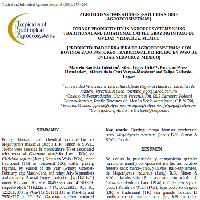Resumen
-
Forage biomass and chemical composition of Megathyrsus maximus (Jacq.) B.K. Simon & S.W.L. Jacobs were assessed in monoculture (P) or associated with trees of Guazuma ulmifolia Lam. (PGu) or Gliricidia sepium (Jacq.) Kunth ex Walp (PGs), under traditional (TG) or rotational (RG) cattle grazing regimes, by season of the year (windy: October-February, dry: March-June, and rainy: July-September) and annually. Annual forage production (kg DM ha-1) under RG and TG was 8049±586 and 4170±319, respectively; 5441±2225 in P-TG, 2022±82 in PGs-TG, 12326±2094 in PGu-TG, 9612±1331 in PGs-RG, and 7976±737 in PGu-RG. Gliricidia sepium produced 1448±2 and 1660±3 kg DM ha-1 year-1 under PGs-TG and PGs-RG, respectively. Forage yield across plant associations and grazing regimes was higher in the rainy season (5333.6±56.7 kg DM ha-1), and decreased
in the windy (2462±349.0 kg DM ha-1) and dry seasons (252.9±2 kg DM ha-1). The PGu system had the highest crude protein content annually (21.8 %) and by season (23.1 %, windy), and also showed the least neutral detergent fiber content during the year (55.2 %) and by season (55.2 %, rainy). Biomass production and chemical composition of M. maximus in monoculture or associated with G. ulmifolia and G. sepium can be increased by modifying the traditional grazing regimes to a more intensive rotational system during the growth period of the year. -
Se evaluó la producción y composición química nutricional anual y por época del año (nortes: octubre-febrero, seca: marzo-junio, y lluvias: julio-septiembre) de Megathyrsus maximus (Jacq.) B.K. Simon & S.W.L. Jacobs solo (P) o asociado con árboles de Guazuma ulmifolia Lam. (PGu) o Gliricidia sepium (Jacq.) Kunth ex Walp. (PGs), bajo pastoreo dirigido (DR) o tradicional (TR) con ganado bovino. El rendimiento de forraje anual (kg MS ha-1) fue
8049±586 y 4170±319 con DR y TR, respectivamente; 5441±2225 en P-TR, 2022±82 en PGs-TR, 12326±2094 en PGu-TR, 9612±1331 en PGs-DR y
7976±737 en PGu-DR. La biomasa anual cosechada de G. sepium fue 1448±2 y 1660±3 en PGs-TR y PGs-DR, respectivamente. La producción mediante asociaciones y tipos de pastoreo fue más alta en lluvias (5261±261 kg MS ha-1) y disminuyó en época de nortes (2462±349 kg MS ha-1) y seca (253±126 kg MS ha-1). En el sistema PGu se observó la mayor cantidad de proteína cruda anual (21.8 %) y por época (23.1 %, nortes), y menor de fibra detergente neutro anual (55.2%) y por época (55.2 %, lluvias). La producción de biomasa y la composición química de M. maximus solo o asociado con G. ulmifolia y G. sepium puede incrementarse al modificar los patrones tradicionales de pastoreo continuo, e implementar un sistema de pastoreo rotacional durante el período de crecimiento.
